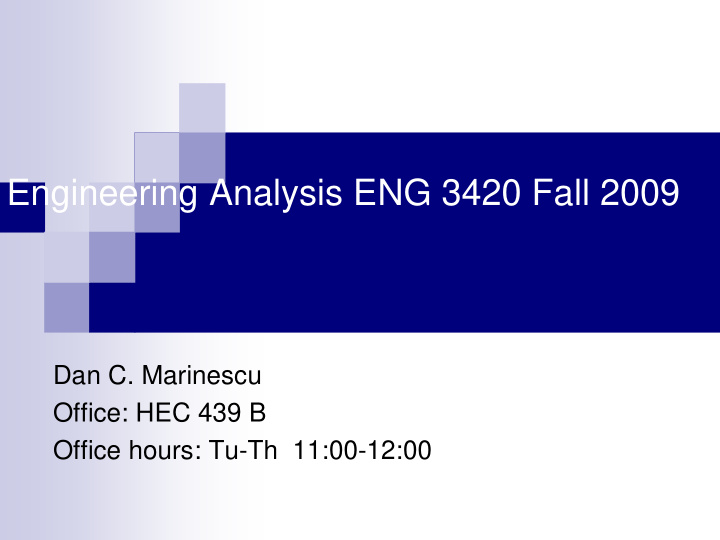



Engineering Analysis ENG 3420 Fall 2009 Dan C. Marinescu Office: HEC 439 B Office hours: Tu-Th 11:00-12:00
Lecture 14 � Last time: � Solving systems of linear equations (Chapter 9) � Graphical methods � Cramer’s rule � Gauss elimination � Today: � Discussion of pivoting � Tri-diagonal system solver � Examples � Next Time LU Factorization (Chapter 10) � Lecture 14 2
function x=GaussNaive(A,b) ExA=[A b]; [m,n]=size(A); q=size(b); if (m~=n) fprintf ('Error: input matrix is not square; n = %3.0f, m=%3.0f \n', n,m); End if (n~=q) fprintf ('Error: vector b has a different dimension than n; q = %2.0f \n', q); end n1=n+1; for k=1:n-1 for i=k+1:n factor=ExA(i,k)/ExA(k,k); ExA(i,k:n1)= ExA(i,k:n1)-factor*ExA(k,k:n1); End End x=zeros(n,1); x(n)=ExA(n,n1)/ExA(n,n); for i=n-1:-1:1 x(i) = (ExA(i,n1)-ExA(i,i+1:n)*x(i+1:n))/ExA(i,i); end
>> A=[1 1 1 0 0 0 ; 0 -1 0 1 -1 0 ; 0 0 -1 0 0 1 ; 0 0 0 0 1 -1 ; 0 10 -10 0 -15 -5 ; 5 -10 0 -20 0 0] A = 1 1 1 0 0 0 0 -1 0 1 -1 0 0 0 -1 0 0 -1 0 0 0 0 1 -1 0 10 -10 0 -15 -5 5 -10 0 -20 0 0 b = [0 0 0 0 0 200] >> b=b' b = 0 0 0 0 0 200 >> x = GaussNaive(A,b) x = NaN NaN NaN NaN NaN NaN
Pivoting � If a coefficient along the diagonal is 0 (problem: division by 0) or close to 0 (problem: round-off error) then the Gauss elimination causes problems. � Partial pivoting � determine the coefficient with the largest absolute value in the column below the pivot element. The rows can then be switched so that the largest element is the pivot element. � Complete pivoting � check also the rows to the right of the pivot element are also checked and switch columns.
function x=GaussPartialPivot(A,b) ExtendedA=[A b]; [m,n]=size(A); q=size(b); if (m~=n) fprintf ('Error: input matrix is not square; n = %3.0f, m=%3.0f \n', n,m); End if (n~=q) fprintf ('Error: vector b has a different dimension than n; q = %2.0f \n', q); end n1=n+1; for k=1:n-1 [largest,i]=max(abs(ExtendedA(k:n,k))); nrow = i +k -1; if nrow ~=k ExtendedA([k,nrow],:) = ExtendedA([nrow,k],:); end end for k=1:n-1 for i=k+1:n factor=ExtendedA(i,k)/ExtendedA(k,k); ExtendedA(i,k:n1)= ExtendedA(i,k:n1)-factor*ExtendedA(k,k:n1); End End x=zeros(n,1); x(n)=ExtendedA(n,n1)/ExtendedA(n,n); for i=n-1:-1:1 x(i) = (ExtendedA(i,n1)-ExtendedA(i,i+1:n)*x(i+1:n))/ExtendedA(i,i); end
A = 1 1 1 0 0 0 0 -1 0 1 -1 0 0 0 -1 0 0 -1 0 0 0 0 1 -1 0 10 -10 0 -15 -5 5 -10 0 -20 0 0 >> k=4; n=6; A(k:n,k) ans = 0 0 -20 >> k=4; n=6; A(2,k:6) ans = 1 -1 0 >> k=4; n=6; [largest,i]=max(abs(A(k:n,k))); nrow = i +k -1, largest, i nrow =6 largest =20 i =3
Tridiagonal systems of linear equations � A tridiagonal system of linear equations � a banded system with a bandwidth of 3: ⎡ ⎤ f 1 g 1 ⎧ ⎫ ⎧ ⎫ x 1 r ⎢ ⎥ 1 ⎪ ⎪ ⎪ ⎪ e 2 f 2 g 2 x 2 r ⎢ ⎥ 2 ⎪ ⎪ ⎪ ⎪ e 3 f 3 g 3 x 3 r ⎢ ⎥ ⎪ ⎪ ⎪ ⎪ 3 ⋅ ⋅ ⋅ ⋅ ⋅ ⎢ ⎥ ⎨ ⎬ = ⎨ ⎬ ⋅ ⋅ ⋅ ⋅ ⋅ ⎢ ⎥ ⎪ ⎪ ⎪ ⎪ ⋅ ⋅ ⋅ ⋅ ⋅ ⎢ ⎥ ⎪ ⎪ ⎪ ⎪ x n − 1 r ⎢ ⎥ e n − 1 f n − 1 g n − 1 ⎪ ⎪ ⎪ ⎪ n − 1 ⎩ x n ⎭ ⎩ r ⎭ ⎢ ⎥ e n f n ⎣ ⎦ n � Can be solved using the same method as Gauss elimination, but with much less effort because most of the matrix elements are already 0.
Tridiagonal system solver
Recommend
More recommend